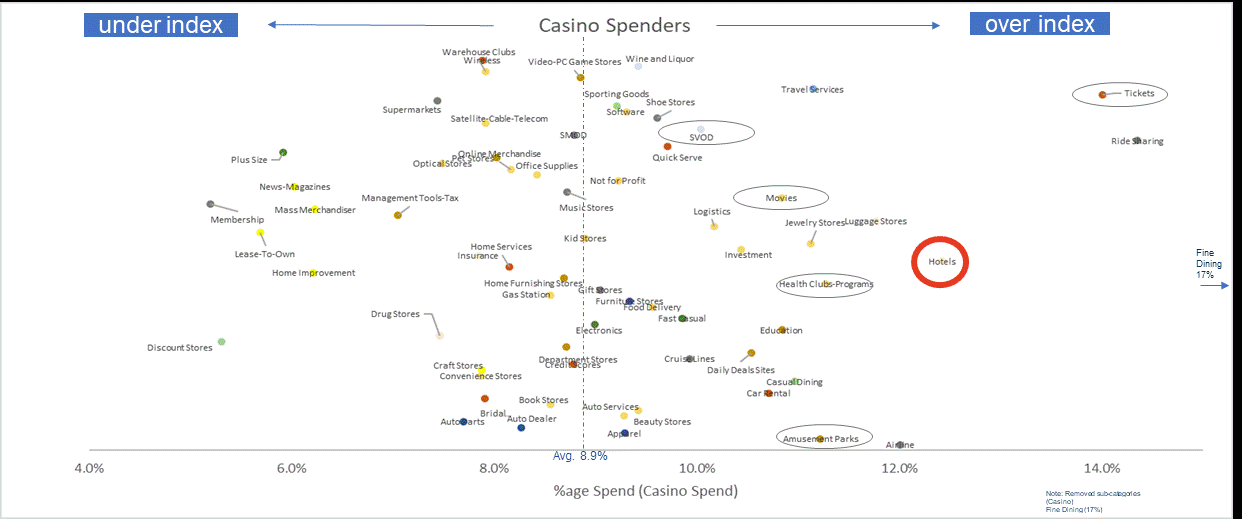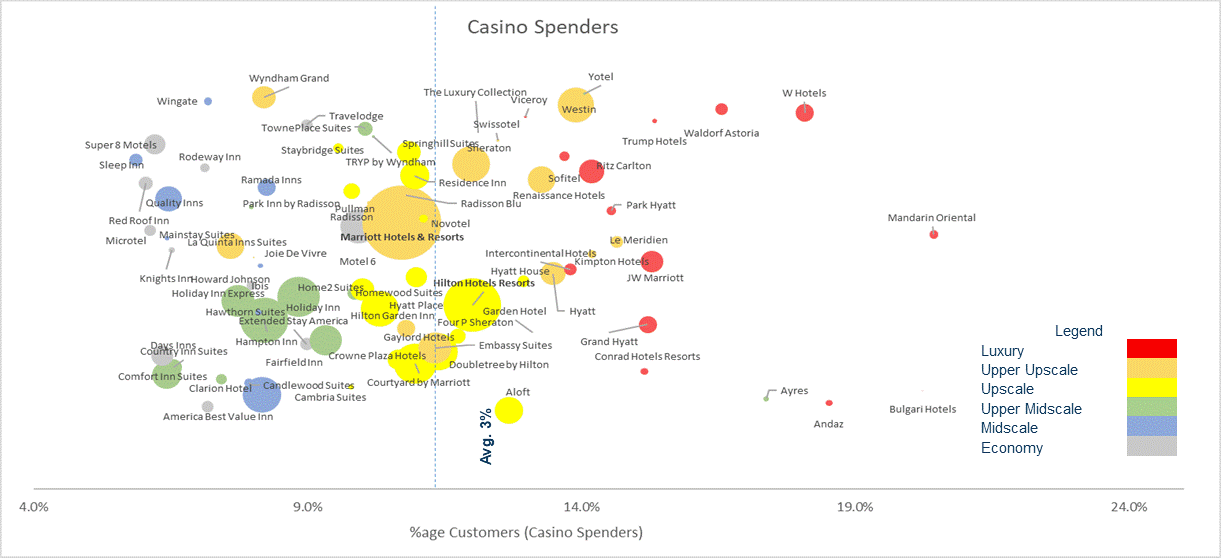


For the past 20-plus years, casinos have been at the forefront of using first-party behavioral data to drive intelligent segmentation and targeting. Now, it’s time to apply that same innovation to leverage third-party data, as well.
Casino marketers have been trained to believe that “External appended data doesn’t predict gaming behavior.” But when it comes down to it, that's not entirely true anymore.
Yes, it's true that traditional demographics like household income or net worth typically don’t have a strong relationship with gaming spend. That said, the casino industry has changed significantly in the past 5, even 10, years that we need to revisit how third-party data can supplement traditional first-party gaming metrics. This is driven by three key factors:
We'll explore these three areas to show why casino marketers should challenge the "first-party data-only" mindset.
MGM Resorts reported at the end of 2020: “Over half of the net revenue from our domestic resorts is typically derived from non-gaming operations.” And Caesars Entertainment reported that non-gaming revenue in 2020 was about one third of their net revenue.
Gaming companies have shifted their marketing strategies to create demand for other revenue sources off the casino floor. Sure, direct mail free play is still a highly relevant customer motivator and expectation. But we’re seeing an increasing push to connect with prospective visitors through amenity offers, too, like lodging discounts, dining upgrades, activities and entertainment. This is especially true for destination markets such as Las Vegas, where casinos fight hard not just for share of gaming wallet but for share of the full entertainment and travel budget.
This focus on amenities aligns perfectly with the growing sophistication available from third-party data providers (see Figure 1 as an example depicting other category spend from casino visitors). Third-party transactional data can show where customer are spending not only with you, but also with your competitors and within other relevant categories. Getting these insights into customer preferences and spend patterns outside your casino bring more information to what content and offers each person actually wants—which goes far beyond what your first-party data alone can inform.
Figure 1: Category spend from casino visitors

Driven by the COVID quarantines and a dramatic shift to remote work, consumers are spending more time online. In fact, the pandemic accelerated the shift to e-commerce by five years. And while this shift has impacted all demographics, SAP reports the largest shift to e-commerce came from boomers, one of the biggest target segments for casinos (their online share of their overall spend grew from 25% to 37%).
This tendency for consumers to now research, socialize, shop and transact online more frequently raises the expectations for a connected and personalized consumer experience. Again, this is a case where your traditional first-party gaming data won’t help inform you on consumers’ wants and needs for an online experience. But with third-party insights and contextual browsing and intent data, casino marketers can understand what their guests and prospects are consuming online and what intent signals they’re showing. This view into other sites visited, common online transactions, interests and hobbies, and countless other individual variables can help create an experience and message that matches actual consumer needs.
Across travel industries, we can have a tendency to look myopically at our competition as just other businesses within our own category (casinos, cruise lines, hotels, airlines, resorts, etc.). But the reality of the consumer perspective is that travelers blur the lines across all of their experiences with brands.
When your VIP guest—let’s call her Jennifer—checks in to her room at Caesars Palace or the Bellagio, she’s not just thinking about her previous casino stays. She’s also comparing her experience to her last business trip to New York, where she stayed at the Four Seasons, or her family vacation to Orlando in May, where they stayed at the Hyatt Regency Grand Cypress.
This multiplies travel marketing messages, as well: Jennifer is getting more than just emails from casinos—she is getting a barrage of communication from travel brands across the industry. Her expectation of each brand’s ability to know her and understand what she needs now and wants next increases exponentially with each brand interaction.
Hotels, cruise lines and other travel brands heavily leverage third-party data. Casinos aren't just in the "gaming" industry anymore; they're competing with travel brands across a consumer's share of travel, and their marketing should reflect that change. With the integration of third-party data, casino marketers are able to see what other brands their customers are engaging with and use that knowledge to help them understand their broader competitive set. (See Figure 2 as an example depicting hotel brand spend from casino visitors.)
Figure 2: Hotel brand spend from casino visitors

We are seeing—not just in gaming, but across all of travel—a reset of customer loyalty triggered by the extended period of no travel. Not all travelers are simply reverting back to their past destinations and loyalty behavior.
With a reduction in travel and an increase in marketing messages, the conversion of travel customers is significantly less than it was 18-plus months ago. How do you set yourself apart, not just from other casinos, but also from all of the travel and entertainment options available?
When marketers leverage all data available to them, they’re able to understand who's willing and able to travel based on past behavior, profile attributes that indicate interest and so much more. The key is that neither first-party nor third-party data stands alone in understanding or driving customer engagement. This approach can help casino marketers move from transactional messaging into conversational or experiential messaging across promotions, food offerings, re-openings, re-engaging past travelers and much more.
Ben Koff, owner of Hidden Upside (a casino marketing consultancy) and head of marketing for Scarlet Pearl Casino Resort in Biloxi, MS, was a contributor to this article. To hear more from Ben on expanding into third-party data and the impacts of the pandemic on casino’s, check out Epsilon’s Vertical Reality: Travel podcast.
Epsilon manages the industry’s no. 1-ranked consumer database, with coverage of every marketable U.S. household. And we continue to optimize our customer analytics offerings through ongoing curation and development. Learn more about Epsilon Data here.